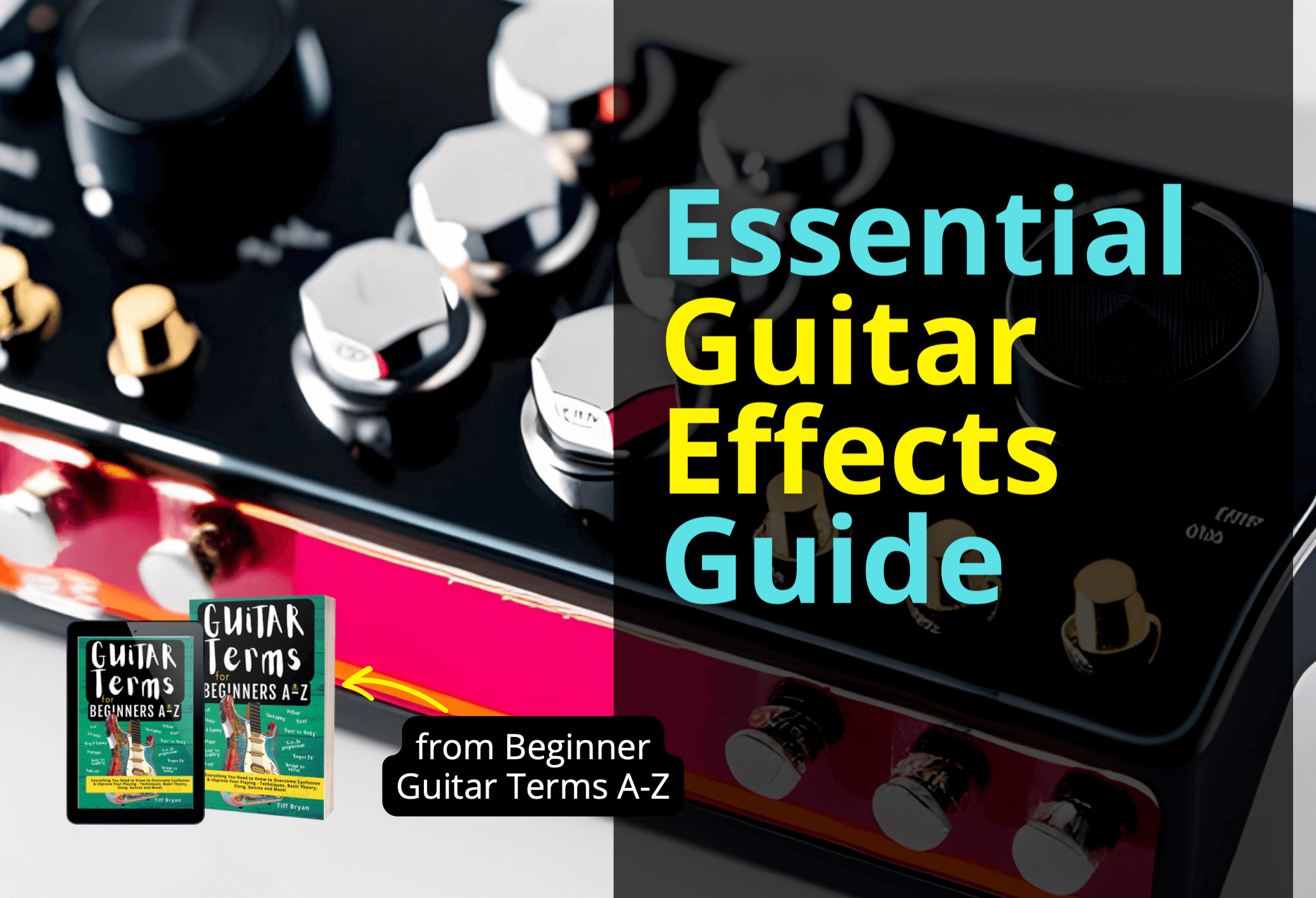From delay to looper to distortion FX pedals, learn the beginner basics of guitar effects and see how they can upgrade your sound…
Guitar jargon can be a real headache for beginners, but it doesn’t have to be. Read an adapted extract from my upcoming book, Guitar Terms for Beginners A-Z, the essential book for any aspiring guitarist.
In the book, you’ll learn the must-know guitar and music lingo in plain English, from “arpeggio” to “guitar action” to why you want to avoid a “fluff”. Say goodbye to confusing guitar terminology and hello to stress-free playing.
In this post, we’ll explore 14 basic guitar effects and learn how they work. I cover all the pedals in the guitar accessories terms section of Guitar Terms for Beginners A-Z.
Let’s get going on this sonic adventure!
Table of Contents
What is a guitar effects pedal?
Let’s start things off with a brief explanation of what a guitar effects pedal is. An effects pedal is an electronic device that changes the sound of an audio source, such as a guitar, by altering the incoming signal to produce specific effects.
Effects pedals are powered by digital or analogue circuitry and are also called ‘stomp boxes’ and ‘FX pedals’. Popular guitar effects pedals include delay, distortion, and vibrato pedals.
What’s the difference between a guitar effects pedal and amp effects?
The main difference between a guitar FX pedal and amplifier effects is that guitar effects pedals are external standalone devices you connect between your guitar and amplifier, while amp effects are built-in features of the amplifier.
With guitar effects pedals, you usually control them using footswitches, so you can quickly turn them on or off as you play. On the other hand, amp effects are adjusted using knobs or buttons on the amplifier.
Are you struggling to decide whether to use effects pedals or rely on amp effects for your guitar playing?
Here are three reasons why many guitarists prefer pedal effects over amp effects:
- Versatility: Effects pedals offer a diverse range of sounds that can be combined in unique ways, creating endless creative possibilities.
- Portability: When it comes to portability and ease of replacement, pedals are the clear winner over amp effects. Their compact size make them a convenient choice for guitarists on the go.
- Tone: The great thing about pedals is that you can mix and match both digital and analog options to create your desired sound.
How do I use a guitar pedal?
Using a guitar pedal is a breeze when you know how. Begin by connecting your guitar to the pedal’s input, and then connect the pedal’s output to your amplifier.
After that, press the footswitch to activate the effect. You can then adjust the settings on the pedal to fine-tune the sound to your liking. When satisfied, release the footswitch to turn off the effect.
14 Most Popular Types of Guitar Effects
1. Chorus Effect
A chorus effect pedal adds a doubled and slightly delayed copy of the guitar signal to create a thicker, richer sound. The delayed signal is also detuned to create a subtle pitch variation that produces a shimmering, watery sound.
Chorus pedals are popular across various music genres for creating a range of sounds, from crisp and sparkling pop tones to harsh, distorted rock and metal tones.
The chorus effect adds depth and dimension to your guitar playing, whether you’re playing rhythm or lead.
Best Chorus Pedals:
Want to add some colour to your guitar tone? These quality chorus effects pedals are worth considering: Boss WAZA Craft Chorus, MXR M234 Analog Chorus, and Electro-Harmonix Small Clone are tried and tested options that will give you great results.
Chorus Effect Song Example: This Charming Man by The Smiths
Listen to Chorus Effect ⬇
2. Compressor Effect
A compressor effects pedal works by reducing the dynamic range of the instrument input signal. Doing this makes the loud parts quieter and the quiet parts louder.
Compressors even out the guitar’s volume and sustain notes longer, which can help add clarity and punch to your guitar tone. Compressor pedals are a must-have for any serious guitarist who plays live or in the studio.
They’re handy for funk, country, and blues styles, where a consistent and balanced sound is essential.
Best Compressor Pedals:
Some respected compressor FX brands that suit different playing styles and budgets are Keeley Electronics, Boss CS-3 Compressor and MXR Dyna Comp Deluxe Compressor. If you’re on a tight budget, this compressor pedal from Donner has some great reviews and won’t break the bank.
In the audio example below, notice how the overall volume of the recording is louder and more even than the other audio examples. That’s the compressor working its magic. Take a listen.
Compressor Effect Song Example: Long Train Running by The Doobie Brothers
Listen to Compressor Effect ⬇
3. Delay Effect
Delay effects pedals create an echo effect by repeating the original sound source after a short delay. Delay creates exciting rhythmic patterns and adds depth to a guitar sound by adding a sense of spaciousness and ambience.
Delay pedals are a staple on many guitarists’ pedalboards, and for good reason. They offer a range of sounds and creative possibilities that can enhance your playing and inspire new ideas.
With so many options available, from analogue to digital, tape to modulated, it’s easy to find a delay pedal that suits your unique style and preferences.
Best Delay Pedals:
Whether you want to create soaring leads or atmospheric soundscapes, our top delay pedals recommendations include the MXK Carbon Copy Analog Delay, TC Electronic Guitar Delay and Boss DD-8 delay pedal. Another notable delay pedal mention goes to the Electro-Harmonix Deluxe Memory Boy.
Delay Effect Song Example: Brighton Rock by Queen
Listen to Delay Effect ⬇
4. Distortion Effect
Distortion pedals create a distorted sound by increasing the amplitude of the guitar signal and adding harmonic content. The distortion effects pedal is a staple in the world of rock and metal music.
It adds grit, aggression, and sustain to your guitar tone, giving your riffs that coveted crunch. Nirvana, Metallica, and Black Sabbath are all examples of bands that use distortion in their music.
They use distortion to create powerful, expressive guitar parts that match their genre and mood. Distortion can also be used to add dynamics and contrast to your playing, such as switching from clean to distorted for a chorus or solo.
Rock on dudes!
Best Distortion Pedals:
Some popular distortion pedals include the Boss DS-2 Turbo Distortion Pedal, MXR Distortion+, and Electro-Harmonix Soul Food Distortion.
Distortion Effect Song Example:Smells Like Teen Spirit by Nirvana
Listen to Distortion Effect ⬇
5. Flanger Effect
The flanger effects pedal produces a distinctive “whooshing” sound by delaying and modulating the guitar signal. The swirling, jet-like effect can add excitement and motion to your playing.
Flanger pedals can be customised to create different sounds by adjusting the effect’s intensity, speed, feedback, and tone. The Strymon Deco, for example, can emulate the sound of tape flanging.
This vintage technique involves manipulating two tape machines to create subtle or dramatic shifts in pitch and phase.
Best Flanger Pedals:
TC Electronic Thunderstorm Flanger and Boss BF-3 Flanger Effects are well-known flanger fx pedals to consider. And check out what has to be the coolest looking pedal on our list, the Walrus Audio Polychrome Analog Flanger Pedal. Dino-tastic!
Flanger Effect Song Example: Spirit of Radio by Rush
Listen to Flanger Effect ⬇
6. Fuzz Effect
A fuzz pedal is a guitar effect that creates a thick, distorted sound by overdriving the amplifier’s input signal. You can use it to create a wide range of effects, from subtle overdrive to extreme distortion. Fuzz pedals are often used in rock music, but they can also be used in other genres, such as blues, metal, and jazz.
The first commercial fuzz pedal was the Maestro Fuzz-Tone, which was famously used by Keith Richards on the Rolling Stones’ hit Satisfaction, released in 1965. The Fuzz-Tone created a distinctive distorted sound that became popular in rock music during the 1960s.
Fuzz FX have been used by legendary guitarists such as Jimi Hendrix, David Gilmour, and Jack White. They have shaped the sound of rock music for decades and inspired countless musicians to experiment with fuzz.
Best Fuzz Pedals:
If you’re ready to experiment with different guitar sounds, try these recommended fuzz pedals: Big Muff Pi, Dunlop Jimi Hendrix Fuzz Face Mini Distortion and MXR Classic 108 Fuzz Mini.
Fuzz Effect Song Example: Cherub Rock by Smashing Pumpkins
Listen to Fuzz Effect ⬇
7. Loop Effect
Also called a ‘looper pedal’, a loop effects unit enables you to record and loop a section of music, creating a layered and repeating sound that can be used for practice, performance, or composition.
Here are some of the ways you can use a looper pedal:
- Create backing tracks: You can use a looper pedal to create backing tracks to play along with to practice your timing and rhythm skills.
- Practice your scales: Loop pedals are a great way to practice your scales. You can create a backing track and play over it to build up to playing solos.
- Experiment with different sounds and effects: Use a looper to experiment with different sounds and effects. This is a great way to find new creative ways to use your guitar.
- Create entire songs: No need for a band when you can loop your guitar riff, add some beats, and create a full song by yourself! And hey, if only the pedal could fetch you a cold one..
Best Looper Pedals:
If you are looking for a way to practice, experiment, and be creative with your playing, then a looper pedal is a great option. Some of the most popular looper models include the Boss RC-5, its big brother the Boss RC-500 Loop Station, and TC Electronic Ditto Looper.
Loop Effect Song Example: You Need Me, I Don’t Need You by Ed Sheeran
Listen to Loop Effect ⬇
8. Multi-Effects Pedal
A multi-effects pedal is single digital effects unit that includes various types of guitar effects, such as distortion, delay and chorus. It allows guitarists to switch between different effects with the press of a button rather than using individual effects pedals.
If you are looking for a way to save money and space on your pedalboard and have various effects at your fingertips, then a multi-effects pedal is a great option.
When choosing a multi-fx, consider the following factors:
- Number of effects: Decide how many different effects you need. Some multi-effects pedals have dozens of effects, while others have only a few.
- Quality of effects: Not all pedals are equal. Some have great distortion but weak reverb. Research and choose a pedal with effects you like.
- Price: Multi-effects pedals can range in price from around $50 to $500. Choose a pedal that fits your budget.
- Size: Multi-effects units can come in larger sizes, so make sure to choose one that will fit on your pedalboard if you have one.
Best Multi-Effects Pedals:
Some of the best guitar multi-effects pedals include: Boss GT-1 Guitar Multi-Effects, Line 6 HX Stomp, Zoom G1X FOUR guitar multi-effects processor (great budget buy). If you’re a serious player with a bigger budget, look no further than the VALETON Multi Effects Processor.
9. Overdrive Effect
An overdrive effects pedal boosts the gain of a guitar’s signal to create a natural-sounding overdrive, similar to a distortion effect. However, unlike the harsh clipping of the distortion pedal, the overdrive pedal emulates the natural breakup of a tube amplifier.
Overdrive pedals can boost the volume, add some edge to a clean guitar tone, or push a distorted amp into more saturation and sustain. They are often stacked with other pedals to create different shades of overdrive.Overdrive pedals are widely used in various genres of music, such as blues, rock, country, and metal.
Best Overdrive Pedals:
Classic examples of overdrive pedals include the Ibanez Tube Screamer, the wonderfully named Fulltone V3 Jekyll & Hyde Overdrive, and finally, the well-loved Boss Blues Driver.
Overdrive Effect Song Example: Surfing with the Alien by Joe Satriani
Listen to Overdrive Effect ⬇
10. Phaser Effect
A phaser effects pedals create a sweeping, swirling sound by splitting the guitar signal, phase-shifting one part, and mixing it back with the original.
This makes a shifting, psychedelic sound that is heard in many classic rock and funk tunes. The effect’s speed, depth, feedback, and tone are adjusted with the typical controls on a phaser pedal.
These parameters change how quickly, intensely, richly, and the effect sounds. Some phaser pedals offer extra features like tap tempo, expression pedal input, stereo output, or different modulation modes. Popular phaser pedals include the MXR Phase 95, Walrus Audio Lillian Analog Phaser and the Boss PH-3.
Phaser Effect Song Example: That Lady by The Isley Brothers
Listen to Phaser Effect ⬇
11. Reverb Effect
By creating reflections and a sense of ambience, a reverb effects pedal can add depth and life to your guitar tone, simulating the sound of playing in a larger space.
Reverb pedals come in various types, such as spring, plate, hall, room, and modulated, each offering a distinct sound based on how the sound is processed and reflected.
For instance, spring reverb delivers a warm and bouncy tone, whereas plate reverb produces a bright and smooth sound. In addition to different reverb types, some pedals also come with extra features like shimmer, reverse, freeze, or delay to add more texture and tonal variety.
Depending on your preference, reverb pedals can subtly enhance your guitar tone or create immersive, atmospheric sounds that transport your audience to another world.
Best Reverb Pedals:
Some of the best reverb pedals include: IK Multimedia AmpliTube X-SPACE Reverb, the pricey but legendary Strymon blueSky Reverberator, and Walrus Audio Slö Multi Texture Reverb. Finally, if you want two effects in one gorgeous-looking pedal, go for the Keeley Caverns V2 Reverb and Delay Pedal.
Reverb Effect Song Example: Hallelujah by Jeff Buckley
Listen to Reverb Effect ⬇
12. Tremolo Effect
The tremolo effect is a modulation effect that creates a rhythmic change in the volume of your sound. It uses an LFO (low-frequency oscillator) to create a waveform that turns the signal up and down.
DeArmond invented the first electronic tremolo device in the early 1940s, which used a motor to shake a canister of fluid that modulated the signal. Later, tremolo circuits were built into guitar amplifiers and effects pedals.
Today, tremolo effects remain popular in various music genres, from country to indie rock, and as you can hear in the audio example below, they can add a pulsating, hypnotic quality to your guitar sound.
Best Tremolo Pedals:
Some great tremolo pedals include the wonderfully simple Boss TR-2 Tremolo Pedal, the pricey but lush Fender MTG Tube Tremolo Pedal and the groovy-looking JHS Tidewater Tremolo Pedal.
Tremolo Effect Song Example: Gimme Shelter by The Rolling Stones
Listen to Tremolo Effect ⬇
13. Vibrato Effect
The vibrato effect is created using an LFO (low-frequency oscillator) to vary the pitch of the guitar’s signal up and down.
Depending on the settings and controls, vibrato pedals can create a subtle, gentle modulation or a more intense, warbling effect; you can hear for yourself below.
Some vibrato pedals also offer additional features like expression pedal inputs or tap tempo controls to adjust the rate of the effect in real-time. Guitarists have used vibrato pedals for decades, which remain a popular way to add character to a guitar sound.
Good to know: Vibrato is often confused with the tremolo effect. Some amps and pedals even play along with the joke by swapping the terms just to mess with us guitarists!
Best Vibrato Pedals:
From classic to modern sounds, these recommended vibrato pedals will add some serious flavour to your guitar playing: TC Electronic Tailspin Vibrato, Dunlop Uni-Vibe and Walrus Audio Julianna Deluxe. The last two pedals combine chorus with vibrato.
Vibrato Effect Song Example: Blackhole Sun by Soundgarden
Listen to Vibrato Effect ⬇
14. Wah-Wah Effect
By moving a foot pedal, guitarists can change the frequencies of their guitar signal with a wah-wah pedal. This guitar effect pedal has a filter inside that shifts up and down the frequency range.
This makes a “wah-wah” sound that sounds a bit like a human voice. Many famous guitarists in the 1960s started using wah-wah pedals such as Jimi Hendrix, Eric Clapton, and Keith Richards.
Wah-wah pedals can make different kinds of sounds, from mild to extreme, and they can fit different types of music, like blues, rock, and funk.
Best Wah Wah Pedals:
Some well-known wah-wah pedals are the Dunlop Cry Baby Multi Wah, Jim Dunlop Mini Wah, and the great-looking Hotone Wah Soul Press II. These pedals have classic features that appeal to many guitar players.
Wah-Wah Effect Song Example: Voodoo Chile by Jimi Hendrix
Listen to Wah Wah Effect ⬇
Summing it up
In conclusion, effects pedals are powerful tools that can add depth, character, and creativity to your guitar playing.
So, strap on your guitar, stomp on those pedals, and let your inner tone wizard shine. Remember, the only limit is your imagination (and maybe your pedalboard real estate!).






















